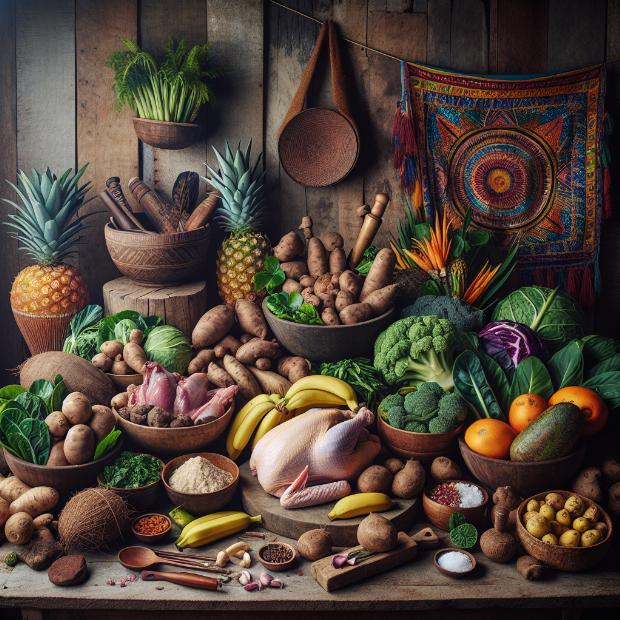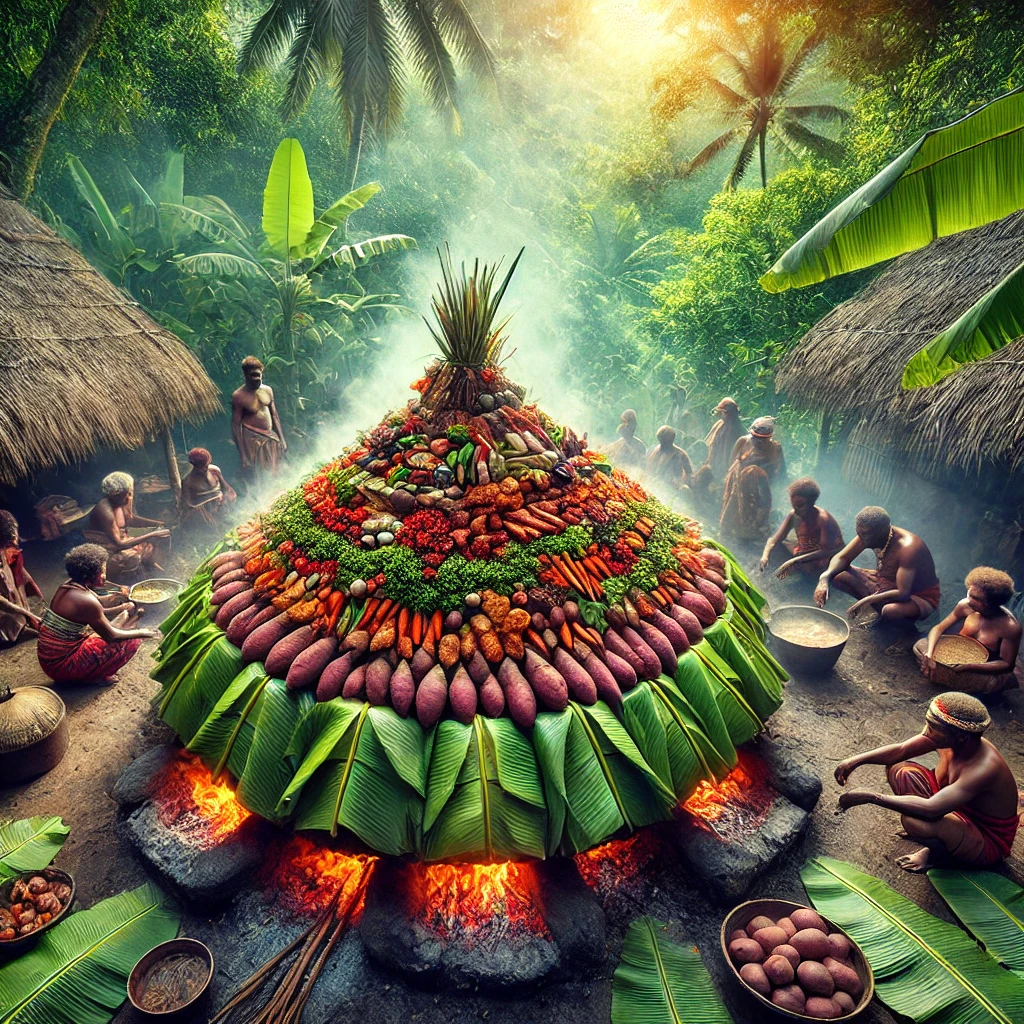Explore Papua New Guinean Mumu Feast
Welcome to our global culinary journey! Today, we shift our focus to the Pacific Islands, specifically the culturally rich nation of Papua New Guinea. The spotlight is on a traditional and renowned feast known as the Papua New Guinean Mumu Feast. This is not just a meal, but an immersive experience that brings together cooking, celebration, and community.
The Papua New Guinean Mumu Feast is a unique culinary event that embodies the spirit of Papua New Guinea, showcasing the country’s rich traditions, diverse ingredients, and the communal way of life of its people. It’s a grand feast prepared with a variety of local ingredients cooked in a traditional earth oven known as a ‘mumu’. This method of cooking, which involves heated stones, banana leaves, and a dug-out pit, is a traditional practice passed down through generations.
In this blog post, we will delve into the details of the Papua New Guinean Mumu Feast, from the meticulous preparation to the joyful communal eating, offering you a virtual taste of Papua New Guinea’s culinary heritage. So, buckle up for an exciting gastronomic adventure, as we explore the delightful intricacies of the Papua New Guinean Mumu Feast.
Papua New Guinean Mumu Feast Recipe
The Papua New Guinean Mumu Feast is a traditional dish enjoyed by the locals of Papua New Guinea. It is not just a meal, but a festive celebration that involves cooking a variety of ingredients like vegetables, pork, and chicken in an earth oven, referred to as a ‘mumu’. Let’s dive into the details on how to prepare this iconic feast.
Ingredients
- Pork meat – 2 kg
- Chicken – 1 whole
- Sweet potatoes – 1 kg
- Plantains – 6
- Green bananas – 6
- Taro roots – 5
- Spinach – 200 g
- Coconut milk – 2 cups
- Salt – to taste
- Fresh banana leaves
- Lemon leaves
- Stones for the mumu (volcanic stones are traditional, but any will do)
- Firewood
Preparation Method
Start by preparing the ingredients. Cut the pork and chicken into large chunks. Peel the sweet potatoes, plantains, green bananas, and taro roots and cut them into sizable pieces. Wash the spinach thoroughly.
Next, you have to construct the mumu, the earth oven. First, dig a shallow pit in the ground and line it with stones. Build a fire with the firewood and let it burn until the stones are red hot.
While the fire is burning, wrap the ingredients. Start by laying down two banana leaves, then place a layer of pork, followed by a layer of chicken, and then a layer of each vegetable. Sprinkle salt to taste, and pour over some coconut milk. Wrap the banana leaves around the ingredients to form a packet.
Once the stones are hot enough, remove some of the firewood to create a space to place the food. Lay down some lemon leaves on the stones, place the banana leaf packets on top, and then cover them with more lemon leaves. Finally, cover everything with some soil to keep the heat and steam in.
Cook the food in the mumu for about 2-3 hours. After this time, remove the soil and extract your feast. Be careful as the food and stones will be very hot. Let it cool down a bit before unwrapping the banana leaves.
Finally, your Papua New Guinean Mumu Feast is ready to be served. Enjoy this traditional feast with friends and family for an authentic Papua New Guinean experience.

The Papua New Guinean Mumu Feast is a traditional cooking method and communal meal that has been passed down through generations. This fascinating ritual is not just about food, but also about community, tradition, and celebration.
One such story that encapsulates the essence of the Mumu Feast involves a small village in the Eastern Highlands Province. The village had been preparing for their annual festival for weeks, and the highlight of the festival was, of course, the Mumu Feast.
The villagers gathered early in the morning to start preparing the feast. Men dug a large hole in the ground and lined it with hot stones heated over an open fire, while women prepared the various foods that would be cooked. The menu included sweet potatoes, taro, bananas, pork, and chicken, all wrapped in banana leaves and placed carefully in the pit.
As the food cooked, the villagers engaged in traditional song and dance, creating a vibrant atmosphere filled with joy and anticipation. The aroma of the cooking food wafted through the air, making everyone’s mouth water.
After several hours of cooking, the food was finally ready. The villagers worked together to carefully remove the hot stones and unveil the feast. The sight of the steaming, cooked food was a delight to behold, and everyone cheered in celebration.
As they sat down to eat, the villagers shared stories and laughter, creating a strong sense of community and unity. The Mumu Feast, in this way, wasn’t just a meal, it was a vibrant celebration of their cultural heritage and a testament to their close-knit community.
This story is a poignant reminder of the cultural significance of the Papua New Guinean Mumu Feast. It’s not just about the food, but also about the process, the communal effort and the shared joy of creating and partaking in a meal together. It’s a tradition that continues to thrive, connecting the present generation to their roots and their community.
In conclusion, the Papua New Guinean Mumu Feast is more than just a meal; it’s a cultural celebration, a symbol of unity, and an immersive experience that engages all the senses. Its preparation involves a lot of patience and hard work, but the end result is worth every bit of effort.
This traditional feast is a wonderful way to connect with Papua New Guinea’s rich heritage and gastronomy. If you ever get a chance to participate in a Mumu, don’t miss it—this is a culinary experience you won’t forget.
For more information and recipes on the Papua New Guinean Mumu Feast, you can explore these authoritative sources: Food Network Papua New Guinean Mumu Feast, Bon Appétit Papua New Guinean Mumu Feast.
If you’re keen on discovering more exotic dishes from around the world, check out these articles:
Discovering the Jordanian Mansaf Lamb Spectacle: A Culinary Journey
Unearthing the Chilean Empanada: An Andean Treasure
Remember, food is a window into a culture, and by exploring different cuisines from around the world, we get to learn and understand more about the diversity that makes our world so unique and beautiful. Enjoy your culinary travels!


Comments
One response to “Exploring Traditional Cuisine: The Papua New Guinean Mumu Feast”
What a fascinating journey into the heart of Papua New Guinea’s culinary traditions! I was particularly struck by the emphasis on community throughout the entire process of preparing and enjoying the Mumu Feast. This isn’t just a meal prepared; it’s a collective effort that brings people together in celebration and unity.
The detailed recipe you’ve provided makes it possible to recreate this unique feast, even if on a smaller scale. I am intrigued by the traditional cooking method using a ‘mumu’, which is a testament to the ingenuity and resourcefulness of Papua New Guinean people.